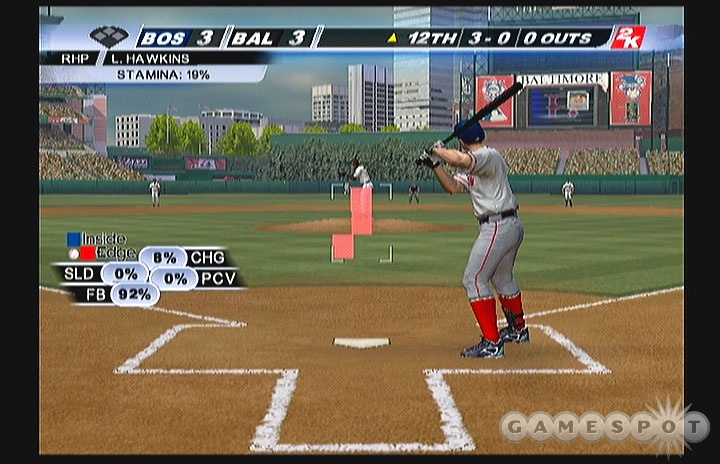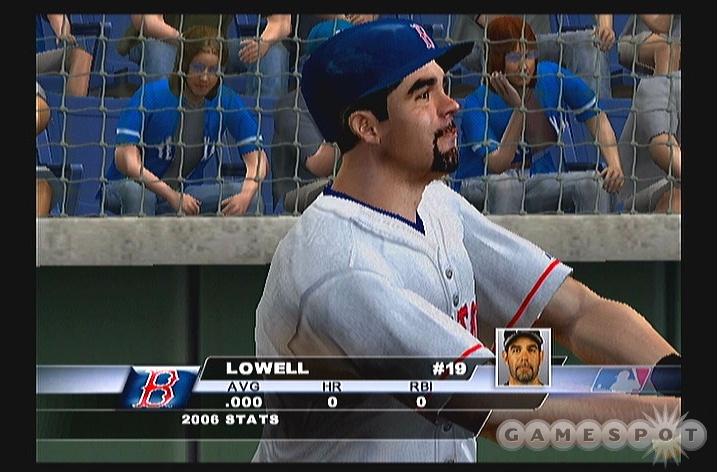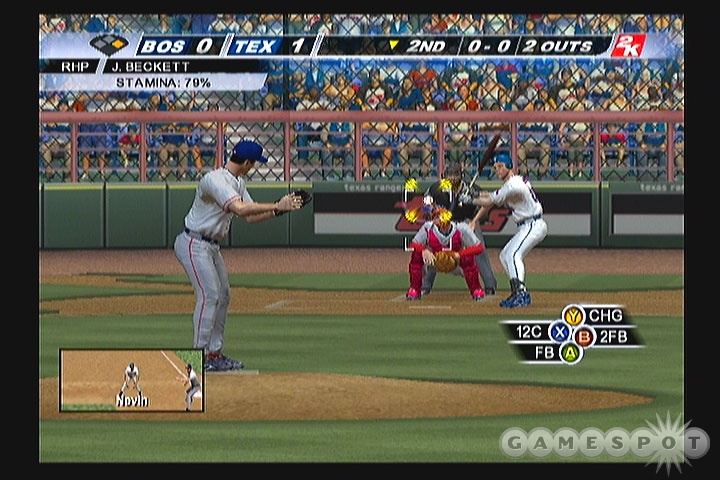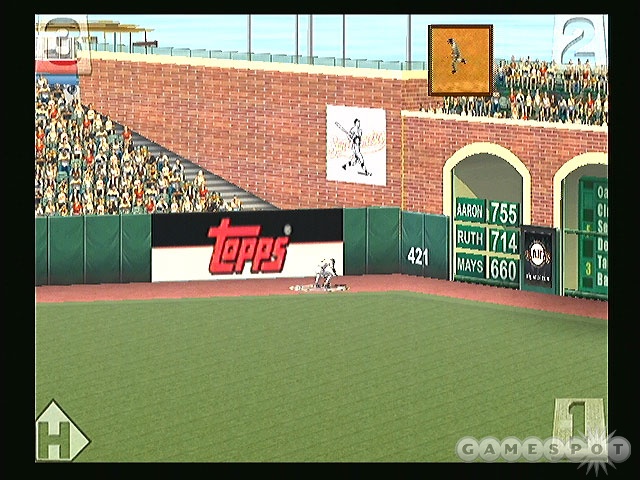While Major League Baseball 2K6 is a deep and feature-rich baseball simulation, it is also very bland in execution. Dyed-in-the-wool simmers will appreciate the game's stats-focused gameplay, as well as its comprehensive online mode, but anyone who's accustomed to the wealth of play animations and broadcast-style nuances found in other games will find this one a snoozer by comparison.

There's certainly nothing wrong with the variety of modes and options. Team selection includes all 30 current MLB rosters and stadiums, along with about a dozen classic and superstar teams. The list of play modes includes single game, season, franchise, GM career, home run derby, playoffs, situation, and managerial showdown choices, as well as a basic World Baseball Classic tournament mode. Due to licensing issues, the WBC mode doesn't feature any non-MLB players or stadiums, although all of the uniforms and team logos are accurate. Multiple difficulty settings, control configurations, and adjustment sliders let you tweak the game to your liking.
2K6 also has a feature-packed online mode. All of the standard features have been implemented, including roster downloads, single-game play, friends lists, and message boards. Additionally, users can set up and manage their own tournaments and leagues. As many as 16 people can participate in tournaments, while leagues allow for as many as 30 participants. The server handles scheduling and automatically keeps track of standings and a full range of statistics. One feature that 2K6 offers that no other console baseball game does is the ability to trade players in league play. As Paris Hilton would say, that's hot.
Not so hot is that games played in the online mode are missing all of the incidental cutaways and broadcast transitions found in offline games. There aren't any cutscenes whatsoever during online games, so you won't see player intros, home run celebrations, or transitional camera shots. After a batter is retired, the next one simply appears. Some people may prefer this sort of streamlined online experience, but the effect of seeing new players appear and having the sides switch immediately without any kind of cue is actually rather jarring. If the announcers lag behind on a call, it's not unusual for someone playing online to sit there not realizing that it's now their turn to hit or pitch. A better compromise would have been to give players the option to enable cutscenes, which they could skip by tapping a button. In any event, apart from the lack of transitions, games played online do seem to flow smoothly, even when the connection quality isn't stellar.
As it is, in its offline modes, the game doesn't exactly impress with cutscenes or broadcast-style transitions. In fact, compared to other console baseball games, the presentation here is absolutely conservative. That's ultimately the biggest problem with Major League Baseball 2K6. All of the technical stuff is fine. The graphics are crisp, the player and stadium models are mostly accurate, the scoreboards update, the physics seem believable, and the animation is smooth. There's just no personality to any of it. On the field, you'll see the same canned putout and double play animations every time. Off the field, there are automatic instant replays and highlights, but they're infrequent and awkwardly brief. Other incidentals, like batter walk-ups and post-strikeout reactions, are also the exception rather than the norm. It makes sense that 2K Games would have to sacrifice some broadcast authenticity when EA Sports locked up the exclusive rights to the ESPN license, but that still doesn't sufficiently explain why MLB 2K6 feels so lifeless compared to MLB 2K5.
It's also worth mentioning that graphics in the PS2 version of the game aren't quite as detailed or steady as those in the Xbox game. Players in the PS2 game have a lower polygon count and don't blink or make facial gestures like the players in the Xbox version do. Looking at the crowd, the spectators in the PS2 game are a mixture of animated polygon models and nonmoving cardboard cutouts. In the Xbox game, every spectator is a 3D model. Also, in close-up views, the visible outlines surrounding individual spectators in the PS2 game can prove distracting. Meanwhile, the constant disc accessing sometimes has a negative effect on the PS2 game's frame rate, causing the action to skip at times. Individually, all of the flaws are minor. Taken as a whole, though, they make the PS2 version of MLB 2K6 look a bit rough around the edges compared to the games that EA Sports and Sony put out earlier this year.

The audio portion of the presentation fares a little better, although the booth crew could definitely use a few cups of coffee to perk them up. ESPN's Jon Miller and Joe Morgan, arguably the best commentator team in baseball today, have the in-game play calling duties. They keep pace with the action fairly well and have a lot to say, but their calls don't exude much in the way of emotion. Otherwise, the rest of the atmospheric audio is suitably peppy. The volume of the crowd turns louder and stadium speaker cues become more frequent in exciting situations. Also, just in general, there's a satisfying range of sound effects, general stadium announcements, and player-specific crowd catcalls.
It's a shame that the presentation is so lackluster, because the gameplay is actually quite compelling. Aspiring GMs will adore the franchise and GM career modes, which feature actual managers and coaches, two levels of minor leagues, trades, drafts, and realistic player progressions. The franchise modes in MLB 2K6 don't let you set concession prices or sell advertising, but they do implement player morale and fatigue as day-to-day variables, which you can subsequently manage by shuffling lineups and adjusting how much time off your players get. Stats are automatically tracked in more than 100 individual categories and sub-categories. On the field, the CPU plays a smart game and is relatively aggressive on the bases. Nitpickers will notice that hits are somewhat easy to get on the default pro difficulty setting, but that's easily fixed by upticking to a higher setting or adjusting any of the 40-plus tuning sliders.
New to Major League Baseball 2K6 is its Inside Edge system. Besides incorporating scouting reports and statistical data into player strengths and CPU behavior, the Inside Edge system will actually make hitting and pitching suggestions to you on a pitch-by-pitch basis during the game. When you're on defense, the game will suggest the most effective pitch and location based upon the hitter's past performance in that particular count. When you're on offense, the game will show you how likely a pitcher is to throw each of his pitches, as well as display the three most likely spots where the next pitch will be located. What makes Inside Edge so captivating is that there's still a margin of error involved, meaning that you still have to factor your own hunches and baseball knowledge into each situation.

On the field, you can literally control every aspect of a ballgame. Managerial functions let you make substitutions, warm up pitchers, and visit the mound whenever you like. If the umpire makes a close play or a batter gets beaned, sometimes the game will prompt you to argue the call or charge the mound. Doing so, however, may result in your manager or player being ejected. The fielding and baserunning interfaces are mostly identical to those in other games. Leadoffs and stolen-base attempts can be queued up before the pitch, and you can command a player to make a diving catch or slide into a base just by pulling on the right analog stick. As in previous years, MLB 2K6 is the only baseball game that lets you compel runners and fielders to kick in an extra burst of speed by rapidly tapping the relevant buttons. The risk of injury or fatigue is higher when kicking in the afterburners, though.
There are two hitting interfaces to pick from. The default lets you swing the bat with the right analog stick. You pull back on the stick to take a step and then either let go for a contact swing or push the stick upward for a power swing. Unlike other games that have tried miserably to implement analog batting, MLB 2K6 succeeds because the input is responsive and because you don't have to put effort into a full motion unless you want to swing for the fences. If you don't like the swing-stick interface, you can always switch to the classic button-based interface in the setup menu. Both interfaces let you target your swing to specific spots in the strike zone by aiming a circular batter's-eye indicator, which may appear large or small depending on the hitter's plate discipline in real life. Wisely, the development team eliminated the controversial slam-zone function from the hitting interface in this year's game. Home runs were too easy to hit in MLB 2K5 thanks to slam zone.
MLB 2K6 employs its own take on the meter-style pitching that's all the rage in baseball games these days. Pitches are selected and aimed using the buttons and left analog stick. When you press the button to select a pitch, the targeting cursor grows into a large circle that gets bigger the longer you keep the button held. This indicates how much power or break you've built into the pitch. Letting up on the button locks in the effectiveness and causes the circle to quickly collapse into a crosshair. You then have to tap the button one more time to lock in the accuracy. The smaller the circle is, the more accurate the pitch will be. In practice, it's a highly intuitive system that boils the complex art of pitching down to a couple of quick button presses.
Another welcome change this year is that it's now possible to specify where the catcher sets up for each pitch. While pitching, you can point the right analog stick to position the catcher's glove over any of eight spots around the strike zone. This lets you psych out players by setting up outside for inside pitches and inside for outside pitches. It's also the key to the game's optional payoff-pitch mechanism. In a real baseball game, a pitch made on a two-strike count is called the payoff pitch, because the pitcher's confidence can be shaken or strengthened based on whether the next pitch is a ball, a hit, or a strike. MLB 2K6 simulates this when you choose to position the catcher on a two-strike count. If your pitch lands in the glove without causing the catcher to move, you'll add a couple of points to your pitcher's effectiveness rating. If the catcher has to move to catch the ball, you'll lose a couple of points. Perhaps the implementation is a little bizarre, but the ability to adjust the catcher is still a welcome addition.

Granted, certain aspects of gameplay could be better. The fielders forget to catch the ball once in a while, and they're a bit on the slow side when changing directions. For offline games, you can alleviate both of these to some extent by cranking up the sliders in the tuning menu. For online games, you're pretty much out of luck. Also, foul balls and bloop hits probably should occur more often. On the whole, though, these kinds of nitpicks are the exception, not the rule. MLB 2K6 gets much more right than it does wrong.
Here's hoping that 2K Games will beef up the presentation and atmosphere in next year's installment to match the already rich gameplay and features. Major League Baseball 2K6 is by no means a bad game, but its portrayal of the sport is apathetic compared to other recent console baseball sims.